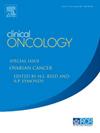18F-PSMA-1007正电子发射断层扫描-计算机断层扫描对高危非转移性前列腺癌初始阶段的实际经验:扫描结果和治疗决策
IF 3
3区 医学
Q2 ONCOLOGY
引用次数: 0
摘要
目的最近的文献表明,前列腺特异性膜抗原正电子发射断层扫描(PSMA-PET)扫描在适合根治性治疗的高危局部前列腺癌患者中的分期准确性高于常规成像。全威尔士指南建议在2020年进行根治性治疗之前进行PSMA-PET扫描。材料和方法我们研究了在卡迪夫进行分期PSMA-PET CT扫描的高危前列腺癌患者的结果,以确定淋巴结或远处转移的比例,危险因素与PET阳性之间的关系,PET结果如何改变治疗方法,以及接受手术的男性的结果。结果200例患者行PSMA分期PET扫描,其中143例常规影像学未发现或怀疑淋巴结或远处转移。143例患者中,分别有102例(71%)、25例(17.5%)和16例(11.2%)的pet后分期为TxN0M0 (PETN0M0)、TxN1M0 (PETN1M0)和TxNxM1 (PETM1)。有1、2、3个高危因素的男性发生显微淋巴结或远处转移的风险分别为12%、38%和72%。风险也随着每个风险因素程度的增加而增加。在接受前列腺切除术的22例PETN0M0疾病患者中,淋巴结假阴性率为9.1%,尽管发现的淋巴结中位数仅为8个。考虑到整个200例患者队列,PET结果强烈影响治疗:56%的PETN0M0男性对前列腺进行根治性治疗,37%对前列腺+淋巴结进行根治性治疗,87%的PETN1M0男性接受前列腺和盆腔淋巴结放射治疗,长期雄激素剥夺治疗(ADT)±雄激素受体途径抑制剂(ARPI),而95%的PETM1患者接受永久性ADT治疗±放疗±ARPI。结论本研究结果反映了国际文献,有力地支持了分期PSMA-PET扫描在所有高危前列腺癌患者根治性治疗前的作用。应考虑将其扩展到不利的中等风险。本文章由计算机程序翻译,如有差异,请以英文原文为准。
Real-World Experience of 18F-PSMA-1007 Positron Emission Tomography-Computed Tomography Scanning for Initial Staging of High-Risk Nonmetastatic Prostate Cancer: Scan Results and Treatment Decisions
Aims
Recent literature has shown the higher accuracy of staging prostate-specific membrane antigen positron emission tomography (PSMA-PET) scans over conventional imaging for high-risk localised prostate cancer patients suitable for radical treatment. All-Wales guidelines recommended PSMA-PET scans prior to radical therapy in 2020.
Materials and Methods
We have studied the outcome of high-risk prostate cancer patients referred for a staging PSMA-PET CT scan in Cardiff to identify the proportion for nodal or distant metastases, the association between risk factors and PET positivity, how treatment varied by PET result, and the outcome of men undergoing surgery.
Results
Two hundred men underwent staging PSMA PET scans, of whom 143 had no evidence or suspicion of nodal or distant metastases on conventional imaging. Of these 143 patients, 102 (71%), 25 (17.5%), and 16 (11.2%) had post-PET staging of TxN0M0 (PETN0M0), TxN1M0 (PETN1M0) and TxNxM1 (PETM1), respectively. The risk of harbouring microscopic nodal or distant metastases was 12%, 38%, and 72% for men with 1, 2, or 3 high-risk factors, respectively. The risk also increased as the extent of each risk factor increased. The nodal false negative rate for the 22 men with PETN0M0 disease undergoing prostatectomy was 9.1%, despite the median number of nodes identified being only 8. Considering the entire 200-patient cohort, treatment was strongly influenced by PET results: 56% of PETN0M0 men had radical treatment to the prostate and 37% to prostate + nodes, 87% of PETN1M0 men had prostate and pelvic nodal radiotherapy with long-course androgen deprivation therapy (ADT) ± androgen receptor pathway inhibitor (ARPI), whereas 95% of men with PETM1 disease had permanent ADT therapy ± radiotherapy ± ARPI.
Conclusions
Our results reflect international literature and strongly support the role of staging PSMA-PET scans prior to radical therapy in all high-risk prostate cancer patients. Extension to unfavourable intermediate-risk should be considered.
求助全文
通过发布文献求助,成功后即可免费获取论文全文。
去求助
来源期刊

Clinical oncology
医学-肿瘤学
CiteScore
5.20
自引率
8.80%
发文量
332
审稿时长
40 days
期刊介绍:
Clinical Oncology is an International cancer journal covering all aspects of the clinical management of cancer patients, reflecting a multidisciplinary approach to therapy. Papers, editorials and reviews are published on all types of malignant disease embracing, pathology, diagnosis and treatment, including radiotherapy, chemotherapy, surgery, combined modality treatment and palliative care. Research and review papers covering epidemiology, radiobiology, radiation physics, tumour biology, and immunology are also published, together with letters to the editor, case reports and book reviews.
 求助内容:
求助内容: 应助结果提醒方式:
应助结果提醒方式:


